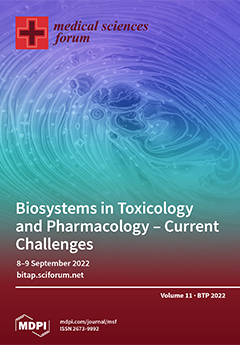Med. Sci. Forum, 2022, BiTaP 2022
Biosystems in Toxicology and Pharmacology—Current Challenges
Online | 8–9 September 2022
Volume Editors:
Ricardo Lagoa, ESTG-Polytechnic Institute of Leiria, Portugal
Paula Videira, FCT-NOVA University of Lisboa, Portugal
Manuel Aureliano, FCT-University of Algarve, Portugal
- Issues are regarded as officially published after their release is announced to the table of contents alert mailing list.
- You may sign up for e-mail alerts to receive table of contents of newly released issues.
- PDF is the official format for papers published in both, html and pdf forms. To view the papers in pdf format, click on the "PDF Full-text" link, and use the free Adobe Reader to open them.



